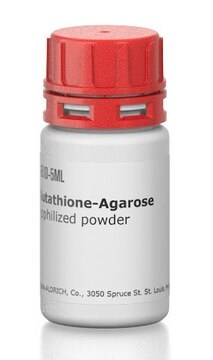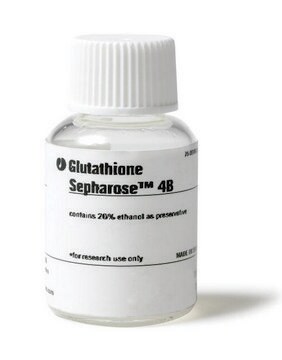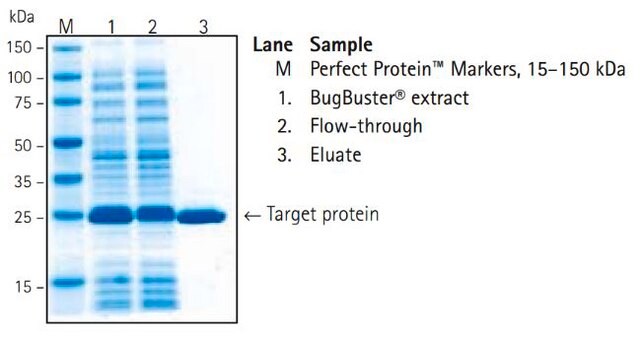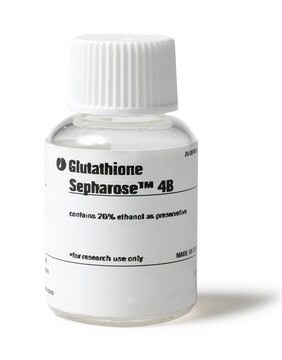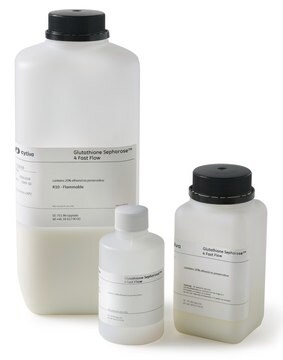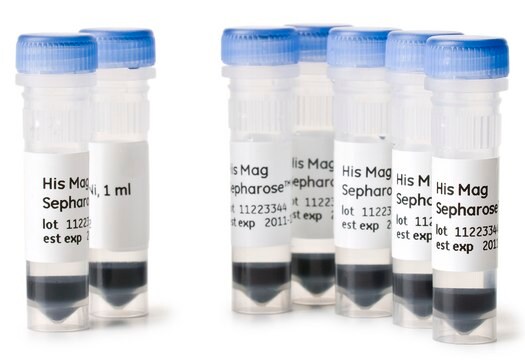Wichtige Dokumente
G0924
Glutathione High Capacity Magnetic Agarose Beads
(1:1 suspension in a 30% ethanol solution)
Synonym(e):
Magnetic agarose beads
About This Item
Empfohlene Produkte
Konjugat
magnetic beads
Qualitätsniveau
Form
(1:1 suspension in a 30% ethanol solution)
chemische Klasse(n) des Analyten
proteins (GST)
Methode(n)
immunoprecipitation (IP): suitable
protein purification: suitable
Matrix
4% beaded magnetic agarose
Matrix-Spacer
12 atoms
Kapazität
≥15 μmol/mL, agarose binding capacity
Versandbedingung
wet ice
Lagertemp.
2-8°C
Suchen Sie nach ähnlichen Produkten? Aufrufen Leitfaden zum Produktvergleich
Allgemeine Beschreibung
The Glutathione Magnetic Agarose Beads are useful for affinity capture, molecular pull-down, or immunoprecipitation (IP) of proteins containing glutathione binding sequences, such as native glutathione S-transferase (GST), glutathione peroxidase, and glyoxalase I, or GST-tagged recombinant fusion proteins from cell lysates or other biochemical solutions while exhibiting low non-specific binding of other proteins. Recombinant GST-tagged proteins, bound to the affinity resin are separated with the use of a magnet. The magnetic properties allow for very rapid processing, as well as aid in manipulations, such as repetitive washings and recovery of the desired protein. This leads to faster recovery, experimental reproducibility, and more accurate quantitation of the proteins of interest.
The matrix of the magnetic beads is a 4% beaded agarose with an average diameter of 50 μ and a diameter range of 20-75 μ. Paramagnetic iron is impregnated within the beads.
Anwendung
Physikalische Form
Signalwort
Danger
H-Sätze
Gefahreneinstufungen
Flam. Liq. 2
Lagerklassenschlüssel
3 - Flammable liquids
WGK
WGK 2
Hier finden Sie alle aktuellen Versionen:
Besitzen Sie dieses Produkt bereits?
In der Dokumentenbibliothek finden Sie die Dokumentation zu den Produkten, die Sie kürzlich erworben haben.
Kunden haben sich ebenfalls angesehen
Verwandter Inhalt
Pull-down assays, reagents, and protocols for investigating in vitro protein-protein interactions using affinity or GST pull-down, tandem affinity purification (TAP), and co-immunoprecipitation methods.
Unser Team von Wissenschaftlern verfügt über Erfahrung in allen Forschungsbereichen einschließlich Life Science, Materialwissenschaften, chemischer Synthese, Chromatographie, Analytik und vielen mehr..
Setzen Sie sich mit dem technischen Dienst in Verbindung.